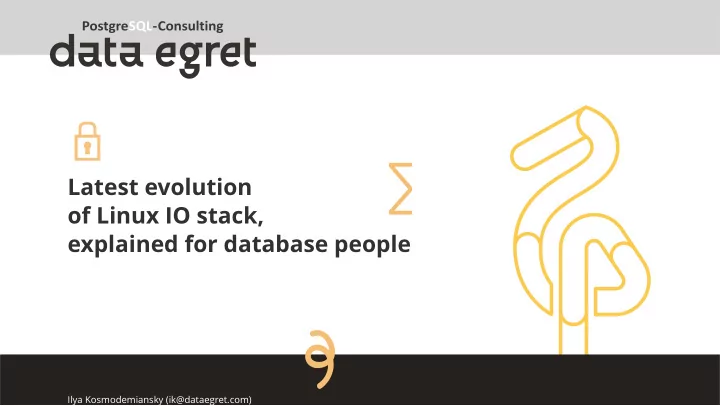

Latest evolution of Linux IO stack, explained for database people Ilya Kosmodemiansky (ik@dataegret.com)
Why this talk 2 • Linux is a most common OS for databases • Fast IO is essential for many workloads • DBAs often run into IO problems • Most of the information on topic is written by kernel developers (for kernel developers) or is checklist-style • Last years Linux IO stack (re)development is very fast dataegret.com
Bird eye view 3 • How a generic database or PostgreSQL interacts with IO • Linux IO as we used to understand it • What is new? dataegret.com
Well, typical database 4 DRAM Shared memory WAL buffer Database User space Linux Kernel space Page cache Disks WAL Datafile dataegret.com
It is easy, while read only 5 select foo from bar where foo=3 DRAM work_mem single worker work_mem shared_buffers work_mem PostgreSQL Linux Page cache Disks dataegret.com
Writes add complexity 6 update foo set bar=buzz DRAM worker shared_buffers WAL buffer PostgreSQL Linux Page cache Page Dirty page Disks WAL datafile dataegret.com
Key things about modern database workload 7 • Shared memory segment can be very large • Keeping in-memory pages synchronized with disk generates huge IO • WAL should be written fast and safe • One and every layer of OS IO stack involved dataegret.com
What generates most of IO in case of PostgreSQL 8 • Keeping pages synchronized: checkpoints and other sync mechanisms • Autovacuum can generate a lot of IO • Cache re fi ll • Worker IO (Sorts and hashing, as well as worst-case fsyncs) dataegret.com
The main IO problem for databases for a long time was 9 • How to maximize page throughput between memory and disks • Things involved: ◮ Disks ◮ Memory ◮ CPU ◮ IO Schedulers ◮ Filesystems ◮ Database itself • IO problems for databases are not always only about disks dataegret.com
The main IO problem for databases for a long time was 10 • How to maximize page throughput between memory and disks • Things involved: ◮ Disks - because latency of this part was very significant ◮ Memory ◮ CPU ◮ IO Schedulers ◮ Filesystems ◮ Database itself • IO problems for databases are not always only about disks dataegret.com
Throughput and latency 11 • Maximizing IO performance through maximizing throughput is easy up to certain moment • Minimizing latency of IO usually is tricky • With large adoption of proper SSDs, hardware latency dropped dramatically dataegret.com
Because of high latency of rotating disks 12 • Database development was concentrated around maximization of throughput • So did Linux kernel development • Many rotating disks era IO optimization techniques are not that good for SSDs dataegret.com
IO stack (as it used to look like) 13 Database memory VFS Page cache Direct IO EXT4 Block IO BIO Layer Request Layer Elevator/IO Scheduler Block device interface Disks dataegret.com
IO stack (as it used to look like) 14 Database memory VFS Page cache Direct IO EXT4 �������������� Block IO BIO Layer ����������������������������� Request Layer Elevator/IO Scheduler Block device interface ������������������ / ������� Disks dataegret.com
Elevators: before 2.6 kernel 15 • Linus Elevator - the only one in times of 2.4 • merging and sorting request queues • Had lots of problems dataegret.com
Elevators: between 2.6 and early 3.* 16 • CFQ - universal, default one • deadline - rotating disks • noop or none - then disks throughput is so high, that it can not bene fi t from keen scheduling ◮ PCIe SSDs ◮ SAN disk arrays dataegret.com
Elevators: 3.13 and newer 17 • Effectiveness of noop clearly shows ineffectiveness of others, or ineffectiveness of smart sorting as an approach • blk-mq scheduler was merged into 3.13 kernel • Much better deals with parallelism of modern SSD - basically separate IO queue for each CPU • The best option for good SSDs right now • blk-mq and NVMe driver is actually more than scheduler, but a system aimed to substitute whole request layer dataegret.com
Old approach to elevators 18 CPU1 CPU2 CPU Elevator Queue Elevator Queue Elevator Queue Elevator Queue Disks Disks dataegret.com
New approach to elevators 19 CPU 1 CPU 2 CPU 3 CPU 4 sw queue sw queue sw queue sw queue hw queue hw queue Disks dataegret.com
IO stack (with blk-mq) 20 Database memory VFS Page cache Direct IO EXT4 Block IO BIO Layer Kyber/BFQ IO schedullers blk-mq NVMe driver Disks dataegret.com
Good diagram on Linux IO stack 21 • https://www.thomas- krenn.com/en/wiki/Linux_Storage_Stack_Diagram • Regular updates • Some things are di ffi cult to draw, but it is a complex topic dataegret.com
Non Volatile Memory Express or NVMe 22 • Sets of standards, which helps to use modern SSDs more effectively • For Linux it is fi rst of all NVMe driver (or subsystem) • Most common example of NVMe SSDs are PCIe NAND drives • With NVMe v.5 (currently 3 is ready for production) can work up to 32GB/sec • Are databases NVMe ready? dataegret.com
Latest development on new block layer 23 • IO polling • New IO schedulers Kyber and BFQ (Kernel 4.12) • IO tagging • Direct IO improvements dataegret.com
Notes on Direct IO 24 • Currently PostgreSQL supports DirectIO only for WAL, but it is unusable on practice • Requires a lots of development • Very OS speci fi c • Allows to use speci fi c things, like O_ATOMIC • PostgreSQL is the only database, which is not using Direct IO dataegret.com
Questions? 25 ik@dataegret.com dataegret.com
Recommend
More recommend